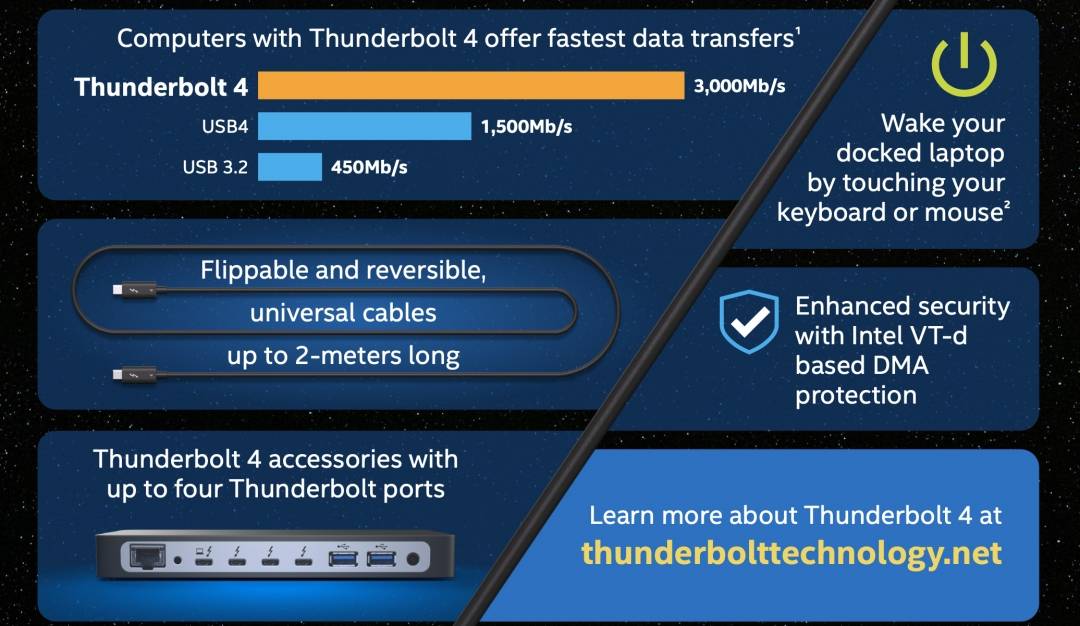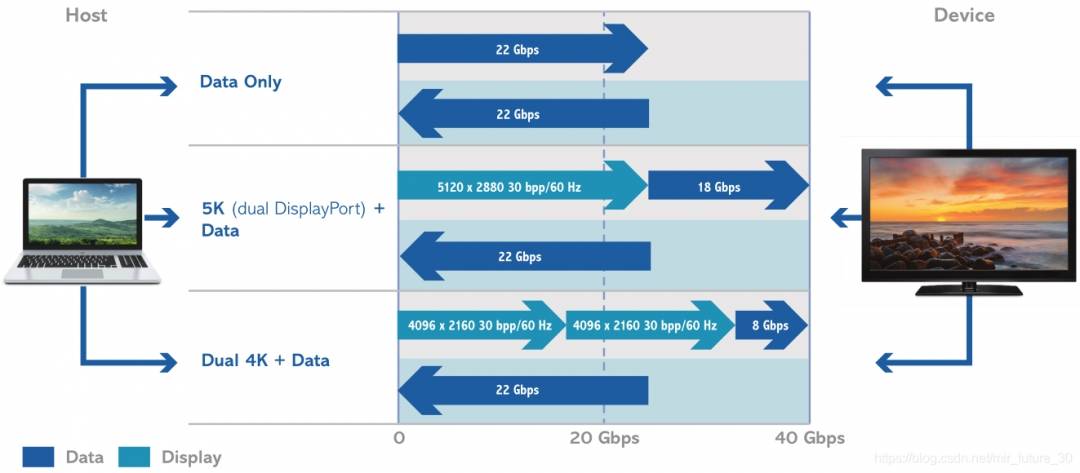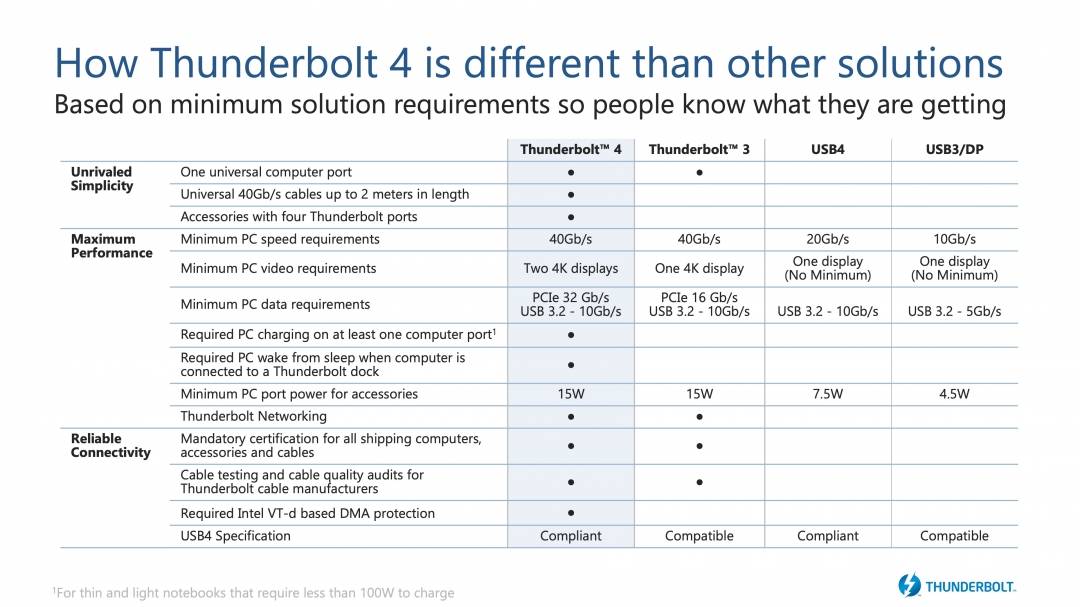The launch of the MacBook series equipped with Apple's self-developed M1 chip not only means that the Mac ecosystem will switch from X86 to ARM, but also represents the first implementation of the USB4 protocol. As the most compatible USB4 protocol at present, it took more than 4 years from its release in August 2019 to the launch of related products in November 2020.

Before the USB4 protocol is installed in products, the Thunderbolt 4 protocol represents the strongest performance. Of course, even if the related products using the USB4 protocol have been launched, the strong position of the Thunderbolt 4 protocol is still unshakable, although they both have a maximum transmission rate of 40Gbps. From the evolution of the Thunderbolt 4 protocol and the USB4 protocol, they can be said to be built based on the Thunderbolt 3 protocol.

The difference is that they have made different derivatives according to their respective application scenarios.
According to convention, Thunderbolt 4 should be upgraded on the basis of Thunderbolt 3, including but not limited to protocol transmission speed and transmission specifications, and the detailed specifications announced by Intel do not seem to have changed much:
1. USB-C interface with the same Thunderbolt 3 protocol and the same maximum rate of 40Gbps;
2. The minimum PC video specification is doubled, supporting two 4K resolution displays or a single 8K resolution display;
3. The data bandwidth is upgraded from 16Gpbs to 32Gpbs, and the speed can reach 3000MB/s when connected to an external storage device, which is close to the performance when installed on the motherboard;
4. Support expansion docks with up to 4 Thunderbolt 4 protocol interfaces, Thunderbolt 4 data cables with a maximum length of 2 meters, and the device can be woken up by an external keyboard and mouse after connecting to the Thunderbolt dock, as well as PC devices equipped with Thunderbolt 4 interfaces, and at least one Thunderbolt 4 interface is provided for device power supply.

From the above improvements, it is not difficult to see that the Thunderbolt 4 protocol is more like a "supplement" compared to the previous generation, and it can even be said to have raised the lower limit of the Thunderbolt 3 protocol. On the other hand, the USB4 protocol, which is also based on the Thunderbolt 3 protocol, has changed a lot compared to the previous generation USB 3.2 protocol, and the "change" is reflected in all aspects.

For example, it has been upgraded to a maximum transmission rate of 40Gbps, supports PD fast charging with a maximum charging power of 100W, can connect two 4K resolution displays or a single 5K resolution display, integrates multiple USB protocols and unifies interface specifications, allowing the USB4 protocol to support more devices, etc.

It is not difficult to find that the USB4 protocol has not only some characteristics of the Thunderbolt 3 protocol itself, but also allows the Thunderbolt 3 protocol to be applied to more devices, while standardizing the interface interoperability and compatibility between various devices. In simple terms, it lowers the upper limit of the Thunderbolt 3 protocol.
Therefore, the relationship between the Thunderbolt 4 protocol and the USB4 protocol is nothing more than mutual complementarity and compatibility. However, since there is a difference between "raising the lower limit" and "lowering the upper limit", it means that they must be somewhat different. Among them, the Thunderbolt 4 protocol has higher constraints on device performance, product certification, etc., while the USB4 protocol requires the versatility and compatibility of the device interface.
Without considering factors such as the maximum transmission rate and interface specifications, only comparing the two from the perspective of device verification testing, it is obvious that devices that support the Thunderbolt 4 protocol will have a better experience, and of course the price will be more expensive. In addition, this also explains why the MacBook series using the M1 chip uses the USB4 protocol instead of the Thunderbolt 4 protocol. The Thunderbolt protocol was first developed jointly by Apple and Intel, but the ownership of the Thunderbolt protocol belongs to Intel, and whether it can be used depends entirely on Intel. However, the Thunderbolt 3 protocol is now open for free and can be used by any device that meets the standards, but the latest Thunderbolt 4 protocol is currently limited to devices equipped with Intel's 11th-generation Core or newer.

The MacBook series using the M1 chip does not use the Thunderbolt 4 protocol, but is equipped with the USB4 protocol and is compatible with the Thunderbolt 3 protocol. Although it does not look as powerful as the Thunderbolt 4 protocol, fortunately it has a maximum transmission rate of 40Gbps, which allows the MacBook series, which already has insufficient interfaces, to expand the interface. Now that the Thunderbolt 3 protocol and USB4 protocol are open, and one day in the future, devices that provide ports with a maximum rate of 40Gpbs will become the norm, and users will be able to feel how "full-blooded" the expansion performance is. When it is no longer connected to an external 4K resolution monitor, it can only be reduced to 1080P resolution for use.

